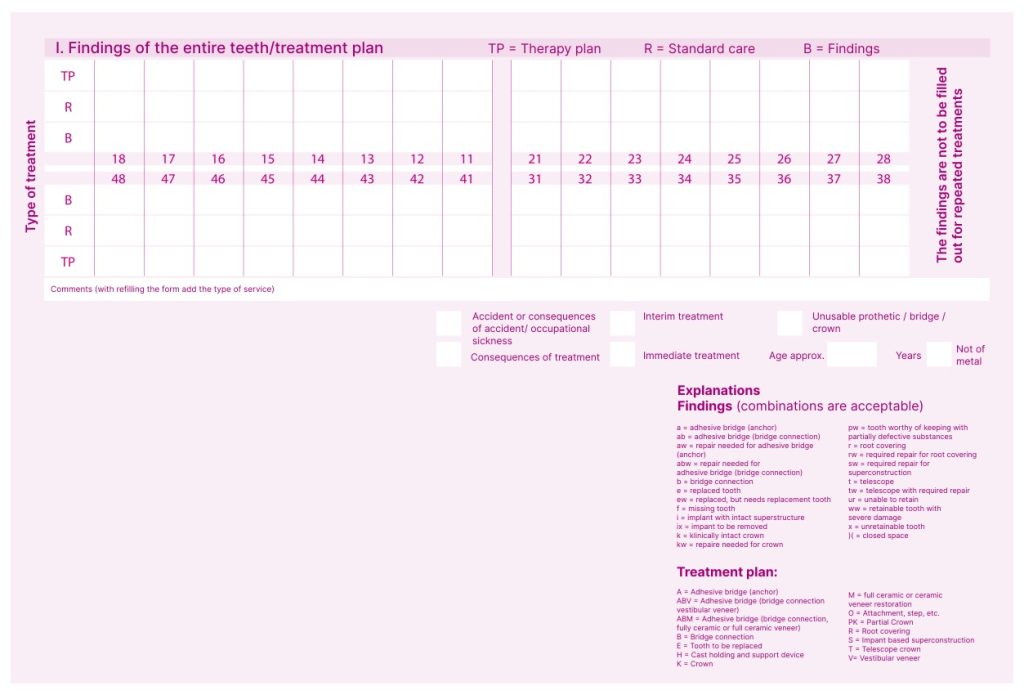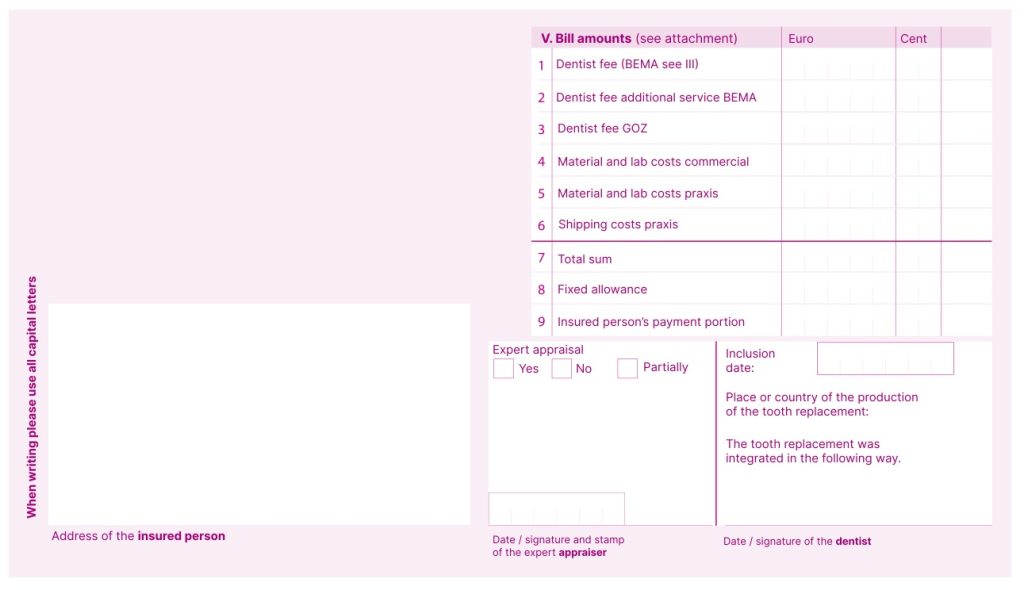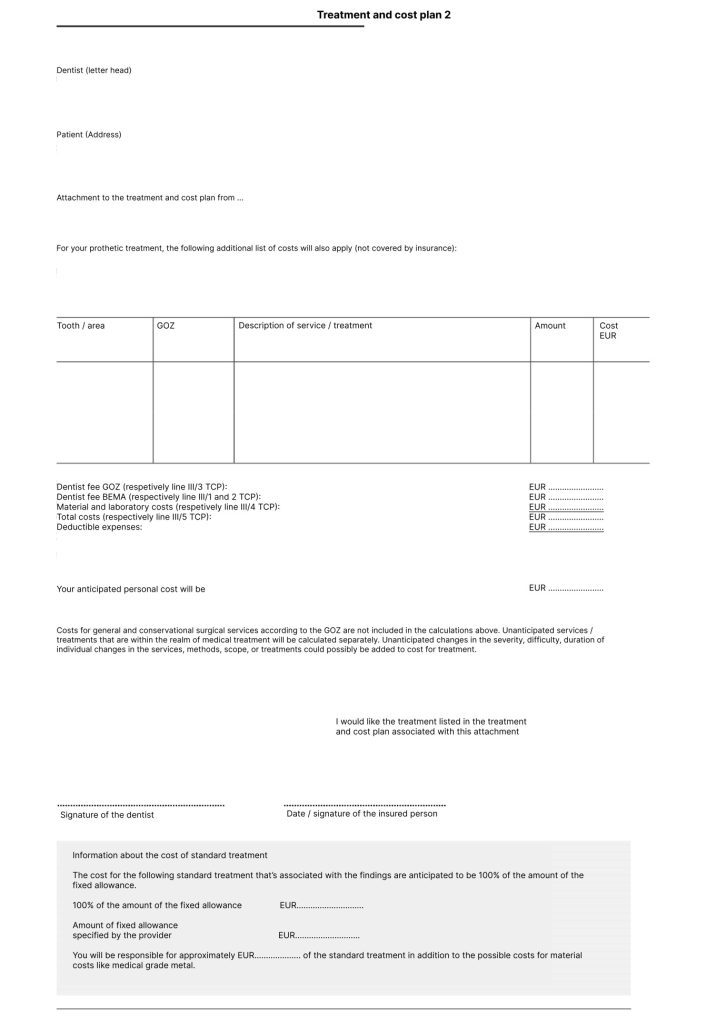A Heil- und Kostenplan is a document used by doctors and dentists to provide you with a cost overview for more expensive healthcare treatments that the doctor or dentist plans to perform. At Feather, we translate this pretty simply as the cost plan.
This must be submitted to your health insurance (both public and private) before the treatment can begin. For public health insurance, you’ll most likely get two cost plans, while private health insurance patients will get one.
After your health insurance provider checks the cost plan, they will let you know how much of the treatment they will cover. This article will go through the most common cost plan (the pink Heil- und Kostenplan) for dental treatment and help you understand what it means.
Section one: general information

The first section of the cost and treatment plan covers your basic information, including your personal details like your name, your health insurance provider, and basic information from the dentist. You’ll need to sign above stating that the information is correct, but none of this is important when understanding your treatment plan and anticipated bill.
Section two: Findings, general treatment, and planned treatment

The second section includes the current state of your teeth. You can see the abbreviations in the following section along with their English equivalents. The lower case letters represent the current problems with the teeth, and the upper case letters represent the treatments.
Because some treatments are covered by public health insurance, and some are not, it’s important to note the difference between standard and planned treatments.
Section three: What’s covered and what isn’t

If you’ve ever gotten a huge bill from the dentist before a tooth replacement and wondered why it’s because it’s not under the list of insured treatments. Your public health insurance provider will only cover certain treatments even if they’re not considered to be the best option.
A good example of this is if one of your back teeth dies and falls out. Public health insurance will pay for a metal bridge that would be attached to the teeth next to the missing one, but this is known to cause long-term damage to the teeth. The best option is an implant, but this is too expensive for public health insurance to cover.
Because you didn’t have supplemental dental insurance, you decide to go for the bridge treatment covered by public health insurance instead of the implant. The next step would be to discuss treatment options for the bridge with your dentist. You’ll have the choice between getting a bridge made of metal (100% covered) or a composite bridge that color-matches to your teeth (around 60% of coverage depending on your Bonusheft or bonus booklet).
What is the Bonusheft?
The Bonusheft or bonus booklet in English is something you need to ask your dentist for immediately. It allows you to earn points for regularly going to the dentist to receive treatment. In the first 10 years, you can get up to 70% of coverage, with 75% being possible after the 10th year.
Your current percentage is listed under the “set coverage” in the cost plan.
Section four: cost planning

You probably didn’t know that doctors or dentists can’t choose their prices at random. Instead, they have to follow BEMA, which is a numbering system for different treatments and how public health insurance providers already know what they can cover or not.
BEMA is used for people insured under public health insurance, while GOZ is for those who pay for the treatment themselves or are insured privately.
For example, the same treatment would look like this:
| BEMA diagnosis and documentation | GOZ diagnosis and documentation |
| BEMA Pos. 4 PA Status | GOZ 4000 PA-Status GOZ 4005 Erhebung Gingivalindex |
| BEMA treatment | GOZ treatment |
| BEMA Pos. P200 | GOZ 4070 oder Implantat |
These are pretty difficult to understand, but the general idea is that if you are under public health insurance, then your diagnosis will be under BEMA, and the treatment will also be under BEMA. The only time someone with public health insurance would be under GOZ is if they opt for treatment that isn’t under BEMA, like getting an implant instead of the bridge.
Section five: billing

The last section of the cost plan is the billing section, where the final amounts go that are connected to public health insurance. You’ll see here there is a section for BEMA and GOZ, as well as confirmation from your dentist and an appraiser from your health insurance. If the planned treatment changes, this document will have to be redone and sent to your public health insurance provider to be re-approved. This generally takes about 3 weeks, but depending on your provider, it might take longer.
Heil- und Kostenplan II

These are treatments that you will need to cover on your own, which is where your supplemental dental insurance will pay. These treatments fall outside the scope of what public health insurance will cover (like getting veneers or an implant instead of a bridge), so they’re listed on a separate cost plan.
Please note that any cosmetic treatments are unlikely to be covered by supplemental dental insurance.
Want to learn more about our supplementary dental insurance?








